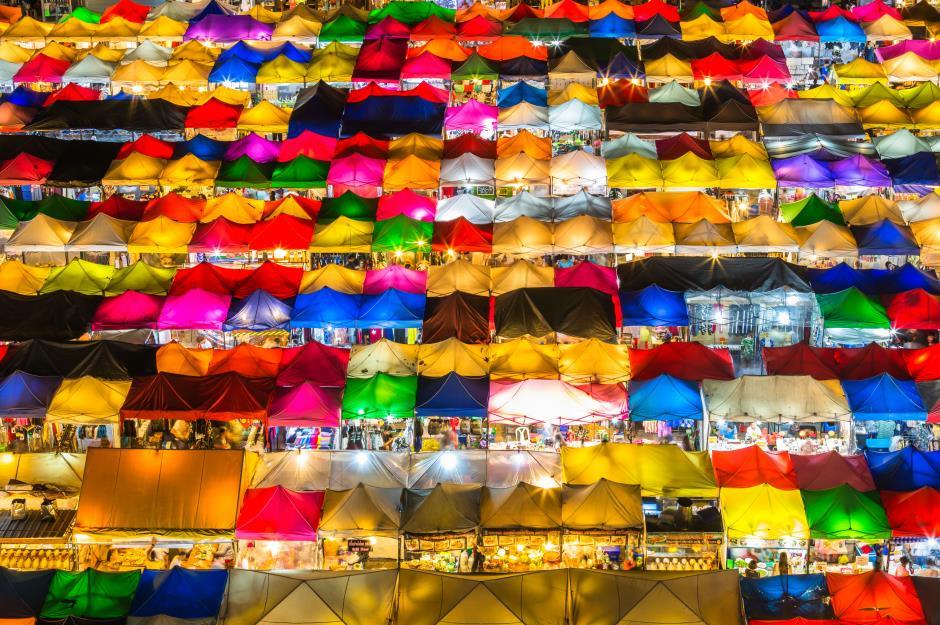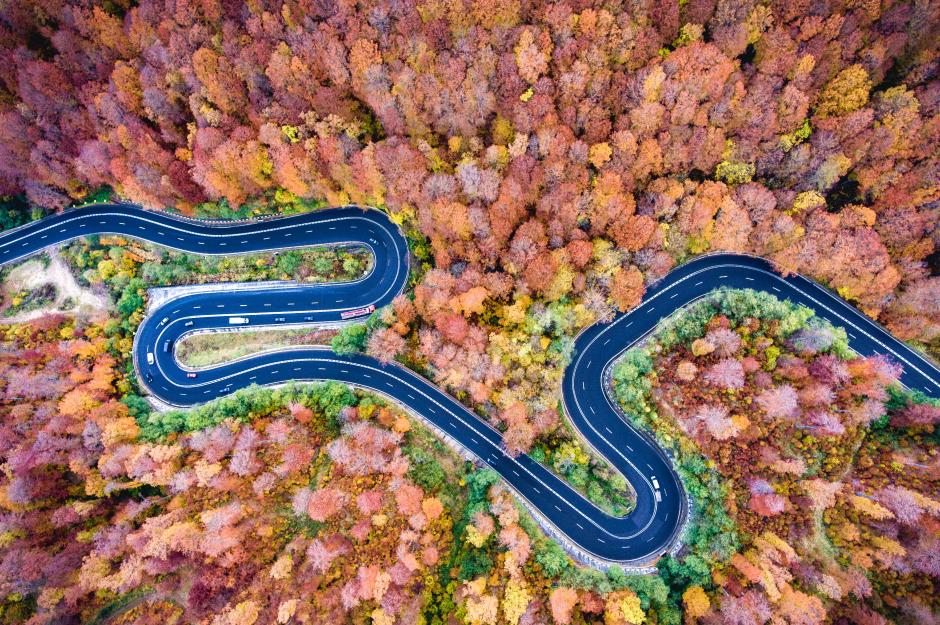When nature looks more like art: astonishing aerial photos of the world
High art
Satellites, planes and drones now give us a bird’s-eye view of the world – and from above, the ordinary transforms into the extraordinary. These aerial perspectives turn familiar landscapes into stunning works of art.
Click through the gallery to see jaw-dropping aerial shots that look like masterpieces...
Mountain pass, Romania
Transylvania is a historical region of Romania that is surrounded by the craggy Carpathian mountain range. Picturesque mountain roads with steep hairpin turns meander through the peaks and spruce forests – a riot of fall colours in autumn and covered in a blanket of snow in winter.
Tulip fields, the Netherlands
Tulips in the Netherlands' flower fields bloom every spring. This beautiful sight is a huge tourist attraction, as well as an economic boon for the country – the Dutch produce more than four billion tulip bulbs each year.
Mine in Xinjiang, China
NASA’s satellite image captures a major mining operation in Lop Nur, part of the autonomous region of Xinjiang. At the end of the last century, large deposits of potash (potassium salt essential to fertiliser) were discovered here in the Taklimakan Desert.
Ice sheet, Greenland
Just inland from the coast of southwestern Greenland you can see the pretty patterns formed by blue pools and crevasses where the meltwater has forced its way through the glacier.
Love this? Follow our Facebook page for more travel inspiration
Lluta River, Chile
In the north of Chile, the arid and remote Atacama Desert receives less than a millimetre of rain a year. From NASA’s Earth Observing-1 satellite, it looks like nothing grows here, although the saline and acidic water of the Lluta has been irrigated for low-quality farmland.
The Dead Sea, Israel and Jordan
The Dead Sea (or Yam-Ha Melah – the Sea of Salt) at the border between Israel and Jordan is the lowest place on Earth. The 'sea' is in fact a lake, and salt fields here are natural works of crystalised art.
Terraced rice fields, Vietnam
The gateway to northwest Vietnam, Yen Bai province is for the most part ignored by tourists, but the stunning landscapes at Mu Cang Chai are worth seeking out. The rice terraces are harvested in September and October when they are at their most beautiful.
Bangkok interchange, Thailand
Toll-controlled access highways criss-cross the capital of Thailand. Built to ease Bangkok’s considerable traffic congestion, the interchanges are as beautiful as they are complex.
Check out these mesmerising images from the Drone Photo Awards...
Pink Lake, Western Australia, Australia
Hutt Lagoon near Port Gregory is one of Western Australia’s famous bubblegum-pink lakes. The result of bacteria in the saline waters, the specific hues change depending on the time of day or year.
The Great Barrier Reef, Queensland, Australia
Australia’s Great Barrier Reef is visible from outer space. This aerial view is from a little closer, but you still get a sense of a vast and complex natural ecosystem.
A scenic flight over the Whitsundays will take you over Heart Reef (pictured), a romantically shaped coral reef that has become an iconic focal point of the Great Barrier Reef Marine Park.
Container port, California, USA
Primary colours and rectangular sea containers makes this pleasing aerial view of a Los Angeles port look almost like a post-modern print.
A solar farm, California, USA
Another post-modern artwork in the making, the grid pattern of these solar panels in a California field could almost have been chosen for its aesthetic value.
Farmland, Kazakhstan
Kazakhstan farmland in the autumn is a beautiful patchwork of green and tan. The contours of the land here, near the border with China, add to the beauty of the landscape.
Staircase in the Vatican Museums, Italy
The 20th-century double helix staircase near the entrance to the Vatican Museums was inspired by an original built in 1505. It is one of the most photographed sights in Vatican City.
Hallstatt in winter, Austria
It’s hard for the eye to discern the town buried beneath the white snow on the shore of Hallstätter See (or Lake Hallstatt). This Austrian town is pretty in the summer months, but looking down from the skies in winter, it looks like an abstract work by a modern artist.
The Nile, Egypt
The Nile flows northward through northwest Africa – here the view is of the river as it flows toward the Mediterranean Sea in Egypt. The longest river in the world is vital to agriculture in the region.
Ratchada Train Market, Thailand
Also known as Talad Nud Rod Fai, this vibrant outdoor night market in Bangkok was established in 2015. With a retro vibe and food zone, it appeals to the city's cool and young creatives.
Chalk Horse, England, UK
This fascinating stylised chalk outline has been part of England’s rolling Oxfordshire Downs since the Bronze Age. Nobody knows why the original horse was etched into the county’s highest hill, but volunteers keep it in chalky white perfect condition.
Jodhpur, India
Okavango Delta, Botswana
Tuscan countryside, Italy
Green rolling Tuscan hills are at the very heart of Italy. From far above, the rural landscape could be an artists’ canvas – and Tuscany has inspired many world-class masterpieces.
John Deere tractor, Italy
Further north, the province of Pavia has equally alluring agricultural views. A John Deere tractor provides the focus for this pastoral scene.
The Nazca Lines, Peru
The stylised geoglyphs originally etched into an arid Peruvian plain more than two thousand years ago are an enigma. Designs include hummingbirds, monkeys, spiders and human figures, and some of them are more than one thousand feet (305m) across. They are best admired from the sky.
Yellowstone National Park, Wyoming, USA
Yellowstone’s Grand Prismatic Spring was created by hot water rising up through cracks in the earth’s surface. The riot of colour is created by heat-loving bacteria – not Photoshop.
Abandoned Housing Development, Arizona, USA
The parched landscape of Arizona provides the perfect canvas for this study in symmetry, created by the roads that were meant to serve houses in this abandoned housing project on the outskirts of Phoenix.
Holmes Beach on Anna Maria Island, Florida, USA
With its miles of gorgeous white-sand beaches, emerald Gulf waters and abundant sunshine, Holmes Beach is popular with vacationers looking for ‘old-Florida charm’ and the chance to spot dolphins, sting rays and manatees in the crystal-clear sea.
Orchard near Siem Reap, Cambodia
Siem Reap is the closest town to the stunning Khmer temples of Angkor Wat. It is also surrounded by orchards growing seasonal fruits like rose apple, jackfruit, mango and star fruit, enjoyed fresh by the tourists that flock here from all over the world.
Sand dune in the Namib Desert, Namibia
The Namib Desert stretches for more than 1,242 miles (2,000km) along the Atlantic coasts of Angola, Namibia and South Africa. It is famous for its towering orange sand dunes that rise 984 feet (300m) high and stretch more than 20 miles (32km) long.
Many of the sand dunes, like the one pictured, feature ‘blowouts’, sandy, bowl-like depressions created by the wind.
Salt lakes in China's Shanxi Province
The vibrantly coloured salt lake in Yuncheng, in the north of China's Shanxi Province, is the third largest sodium sulphate inland salt lake in the world.
Salt has been mined here for over 4,600 years, with the striking magenta, violet and yellow created by a unique species of micro-algae called Dunaliella salina that creates algal blooms.
Combine harvester, England, UK
A combine harvester is seen cutting through an English field, its robotic form creating an almost alien-like presence against the muted brown tones of the landscape. The machine’s path carves satisfyingly perfect lines, turning the rural farming scene into a work of industrial art.
Laguna Rosa, Spain
Located in Torrevieja, southern Spain, this stunning pink lake is famous for its unusual colour. The hue comes from high salinity that fosters algae and bacteria, creating the striking pigment.
Laguna Rosa is also known for its therapeutic mud, which is believed to have healing properties, making it a popular spot for wellness tourists.
Haida Gwaii, British Columbia, Canada
Haida Gwaii, formerly the Queen Charlotte Islands, is an archipelago off British Columbia’s coast, renowned for its lush green landscapes, temperate rainforests and abundant wildlife.
The islands are also famous for their dramatic cliffs, pristine beaches and towering ancient cedar trees, creating a truly breathtaking natural landscape.
Waterfall in Bavaria, Germany
It's not often you see a waterfall from above, and this new perspective of the waterfall near Neuschwanstein Castle in Bavaria transforms it from a stunning nature shot into something altogether more abstract.
Rainbow world: amazing images of Earth’s most colourful natural wonders

